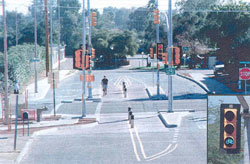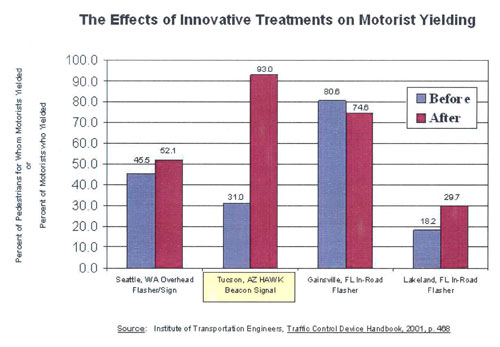Bringing Life to Transportation
Tucson, Arizona
Source: Pedestrian and Bicycle Information Center (PBIC)

Problem
Arizona ranks as the second worst state in the nation for pedestrian fatalities, and in 1998 the City of Tucson had a pedestrian fatality rate of 3.26 per 100,000 citizens.
Solution
Tucson pursued two main avenues: engineering and education. On the engineering side, the city adopted several traffic control measures used in Europe and fitted them to the Manual on Uniform Traffic Control Devices guidelines. The first of these was the PELICAN (PEdestrian LIght ActivatioN ) crossing. This midblock crossing signal has the pedestrian cross the street in two stages. The first signal changes to yellow upon activation by the pedestrian, then to red and the WALK light is shown. The pedestrian then activates a second signal at the median island, following the same pattern. The two crossings only delay the pedestrian minimally and allow the signal operation to fit into the arterial synchronization, thus reducing the potential for stops and accidents. This mid-block crossing was installed along the city's busiest arterial street at a cost of $200,000.
The second system, the TOCAN (TwO CAN) was installed at an intersection frequented by both pedestrians and bicyclists. The "smart" traffic signal lengthens the crossing time when cameras detect bicycles and pedestrians in the same crossing. The ease of activation — just riding up to the stop bar — is a convenience for bicyclists. The signal was implemented on a budget of $175,000.
A third system installed was the HAWK (High intensity Activated crossWalK). When the unit is activated by a pedestrian, the signal begins to flash yellow followed by an indication advising motorists to stop. The signal then is changed to a solid red, indicated by the WALK signal for pedestrians. The beacon then converts to a flashing red, allowing drivers to proceed when safe after stopping at the crosswalk. The HAWK was installed on a budget of $65,000.
A fourth signal, the "baby" PUFFIN (Pedestrian User Friendly Intelligent Crossing), was primarily for school crossings. School crossing guards use this version of the device to control the WALK signal remotely, allowing them to freeze the red light and hold the traffic until the children have adequate time to finish crossing. The device cost only $100 per unit.
The final engineering measure taken by the City of Tucson was the implementation of lagging left turn signals. In this system, the left turn arrow comes after the main street traffic is stopped, separating pedestrians and turning traffic.
Tucson's education program focused on school age children through the "Traffic Safe Kids Program." Their innovative 25 minute presentation to 2nd graders incorporated humor, magic, video clips, and a coloring and activity book featuring Zack Rabbit and Lenny Lizard acting out various risky situations and the proper behavior. At the end of the presentation, students are given safety reflective wrist bands and blinking safety lights to wear when out after dark in addition to coupons for rides and food.
Results
The HAWK signal was evaluated for its effectiveness and found to make a dramatic difference in the number of compliant motorists, raising the percentage of yielding motorists from 31 percent before to 93 percent afterwards. The lagging turn signals were also found to save time, reduce accidents, and lower insurance rates. Tucson's pedestrian fatality rate fell each of the four years after implementation, dropping from 3.26 per 100,000 citizens in 1998 to 2.76 in 2002.

Contact
Richard Nassi, P.E., Ph.D
Transportation Administrator
Traffic Engineering Division
201 N. Stone Ave. 5th Fl.
P.O. Box 27210
Tuscon, AZ 85726-7210
(520) 791-4259
rnassil@ci.tucson.az.us
http://dot.ci.tucson.az.us
Image Sources
Institute of Transportation Engineers Pedestrian Project Awards Application. Tucson Traffic Engineering.http://www.ite.org/awards/pedproject/Tucson.pdf
Institute of Transportation Engineers, Traffic Control Device Handbook, 2001, p. 468




